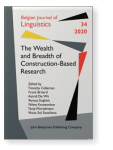Concessive conditionals as a family of constructions
This squib sketches an approach to concessive conditionals (CCs) from the perspective of Radical Construction
Grammar (
Croft 2001). It brings earlier functional-typological work on CCs to bear on
language-particular constructionist analyses of CCs, using the notions of ‘family (of constructions)’ and ‘prototype’ as the bridge.
After suggesting how these notions can be applied to CCs under a functional-typological approach, the structure of the CC
sub-constructicon in German is discussed, and directions for future research are offered to round the squib off.
Article outline
- 1.Introduction
- 2.Concessive Conditionals: ‘Family’ and Family Resemblances
- 3.CCs and prototypes: A typological perspective
- 4.Concessive conditionals in the constructicon: The view from German
- 5.Concluding remarks
-
References
References (31)
References
Baschewa, Emilia. 1983. “Untersuchungen zur Diachronie des Konzessivsatzes im Neuhochdeutschen.” Beiträge zur Erforschung der deutschen Sprache 31: 77–107.
Bossuyt, Tom. 2016. “Zur Distribution von Irrelevanzpartikeln in was immer/auch-Konstruktionen. Positionelle und
kombinatorische Varianz im Deutschen Referenzkorpus.” Germanistische Mitteilungen 421: 45–70. 

Bossuyt, Tom. Subm. “Concessive Conditionals in and beyond Europe.” Under review with Studies in Language.
Bossuyt, Tom, Ludovic De Cuypere, and Torsten Leuschner. 2018. “Emergence Phenomena in W immer/auch-Subordinators.” In Grammar and Corpora 2016, ed. by Eric Fuß, Marek Konopka, Beata Trawinski, and Ulrich Waßner, 97–120. Heidelberg: heiUP. <[URL]>
Bücker, Jörg. 2016. “Focus, Scales and Concessive Conditionals in German.” Language Sciences 581: 163–177. 

Croft, William. 2001. Radical Construction Grammar: Syntactic Theory in Typological Perspective. Oxford: Oxford University Press. 

Croft, William, and D. Alan Cruse. 2004. Cognitive Linguistics. Cambridge: Cambridge University Press. 

d’Avis, Franz-Josef. 2016. “Satztyp als Konstruktion: Diskussion am Beispiel ‘konzessive Konditionalgefüge’.” In Satztypen und Konstruktionen, ed. by Rita Finkbeiner, and Jörg Meibauer, 267–295. Berlin: Walter de Gruyter.
De Vaere, Hilde, Julia Kolkmann and Thomas Belligh. 2020. “Allostructions Revisited.” Journal of Pragmatics 1701, 96–111. 

Diessel, Holger. 2019. The Grammar Network: How Linguistic Structure Is Shaped by Language Use. Cambridge: Cambridge University Press. 

Duffley, Patrick, and Pierre Larrivée. 2020. “
Whatever floats your boat: A Corpus-Based Investigation of Definiteness, Quantification, Modality,
Presuppositional Content, Scalarity and Epistemic Stance with wh-ever Words.” International Review of Pragmatics 121: 206–245. 

Fujii, Seiko Y. 1994. “A Family of Constructions: Japanese TEMO and Other Concessive Conditionals.” In Proceedings of the Twentieth Annual Meeting of the Berkeley Linguistics Society: General Session Dedicated to the
Contributions of Charles J. Fillmore, ed. by Susanne Gahl, Andy Dolbey, and Christopher Johnson, 194–207. Berkeley: Berkeley Linguistics Society. <[URL]> 
Geeraerts, Dirk. 2010. Theories of Lexical Semantics. Oxford: Oxford University Press.
Goldberg, Adele E. 2006. Constructions at Work: The Nature of Generalization in Language. Oxford: Oxford University Press.
Haspelmath, Martin, and Ekkehard König. 1998. “Concessive Conditionals in the Languages of Europe.” In Adverbial Constructions in the Languages of Europe, ed. by Johan van der Auwera, 563–640. Berlin: de Gruyter. 

König, Ekkehard. 1992. “From Discourse to Syntax: The Case of Concessive Conditionals.” In Who Climbs the Grammar Tree, ed. by Rosemarie Tracy, 423–433. Tübingen: Niemeyer. 

Kupietz, Marc, Harald Lüngen, Paweł Kamocki, and Andreas Witt. 2018. “The German Reference Corpus DeReKo: New Developments – New Opportunities.” In Proceedings of the Eleventh International Conference on Language Resources and Evaluation, ed. by Nicoletta Calzolari et al., 4353–4360. <[URL]>
Lehmann, Christian. 1988. “Towards a Typology of Clause Linkage.” In Clause-Combining in Grammar and Discourse, ed. by John Haiman, and Sandra A. Thompson, 181–225. Amsterdam and Philadelphia: John Benjamins. 

Leuschner, Torsten. 2006. Hypotaxis as Bulding-Site: The Emergence and Grammaticalization of Concessive Conditionals in English, German and
Dutch. Munich: Lincom.
Nishigauchi, Taisuke. 1991. “Construing WH.” In Logical Structure and Linguistic Structure: Cross-Linguistic Perspectives, ed. by C.-T. James Huang, and Robert May, 197–231. Dordrecht: Kluwer.
Oppliger, Rachel. 2018. “
Whatever the specific circumstances, …: a Construction Grammar Perspective o[n] wh-ever Clauses in English.” In Subordination in English: Synchronic and Diachronic Perspectives, ed. by Elena Seoane, Carlos Acuña-Fariña, and Ignacio Palacios-Martínez, 263–284. Berlin: Walter de Gruyter. 

Rawlins, Kyle. 2008. “(Un)conditionals: An Investigation in the Syntax and Semantics of Conditional Structures.” PhD dissertation, University of California, Santa Cruz.
Taylor, John R. 2003. Linguistic Categorization: Prototypes in Linguistic Theory. 3rd edition. Oxford: Oxford University Press.
Traugott, Elizabeth C., and Graeme Trousdale. 2013. Constructionalization and Constructional Change. Oxford: Oxford University Press. 

Vander Haegen, Flor. 2019. “Die Emergenz irrelevanzkonditionaler Subjunktoren des Typs egal was. Variation und
Grammatikalisierung anhand des Deutschen Referenzkorpus.” Germanistische Mitteilungen 451: 113–138.
Vander Haegen, Flor, Tom Bossuyt, and Torsten Leuschner. Subm. “Emerging into Your Family of Constructions: German [IRR was] ‘no matter what’.” Under review with Constructions and Frames.
Waßner, Ulrich H. 2006. “Zur Relevanz von und zur Irrelevanz bei Irrelevanzkonditionalen.” In Grammatische Untersuchungen. Analysen und Reflexionen. Gisela Zifonun zum 60. Geburtstag, ed. by Eva Breindl, Lutz Gunkel, and Bruno Strecker, 381–399. Tübingen: Gunter Narr.
Zifonun, Gisela, Ludger Hoffmann, and Bruno Strecker. 1997. Grammatik der deutschen Sprache. 31 volumes. Berlin: Walter de Gruyter.
Cited by (3)
Cited by three other publications
Bossuyt, Tom
2024.
Ole Schützler, Concessive constructions in varieties of English (Language Variation 9). Berlin: Language Science Press, 2023. Pp. viii + 270. ISBN 9783961104222..
English Language and Linguistics ► pp. 1 ff.

Haegen, Flor Vander, Tom Bossuyt & Torsten Leuschner
This list is based on CrossRef data as of 4 july 2024. Please note that it may not be complete. Sources presented here have been supplied by the respective publishers.
Any errors therein should be reported to them.
